Southern California is full of different varieties of mushrooms to forage for. Both beginner mushroom foragers and those with experience can use this list as a starting point for foraging in the southern regions of California.
Black Trumpet (Craterellus cornucopoides)
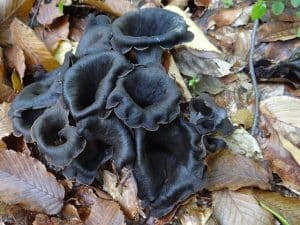
Black trumpet mushrooms are a common black fungus that grows in forests, sprouting from the soil. You will most commonly find the Black Trumpet mushroom alongside the trunk of an oak or beech tree. This mushroom grows in patches, so where you find a few mushrooms, there are sure to be more in the nearby area, forming in clusters that spread between three and 13 feet. Common places to find these patches include logging roadsides, moss patches, and steep banks from June to September. There are no known similar lookalikes to this mushroom.
Mud Puppy Chanterelle (Cantharellus californicus)
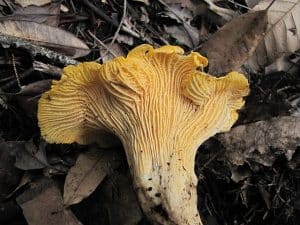
This variety of Chanterelle mushroom is also known as the Oak Chanterelle and is a fungus that is native to California. The Mud Puppy Chanterelle mushroom is a yellow-orange fungus that reaches between two and 12 inches in height. This mushroom is also referred to as the oak chanterelle due to frequently growing near oak trees. The caps are irregularly shaped and have pale-whitish gills underneath. You will most commonly find this fungus in wet habitats.
King Bolete (Boletus edulis)
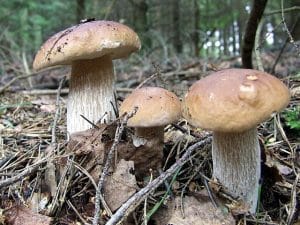
King Bolete mushrooms are also known as Penny Bun or Porcini mushrooms. This mushroom grows in deciduous and coniferous forests, yet is not the easiest mushroom to find, given that it is beloved and quickly eaten by wildlife. They produce spores on a pore surface and not on gills. They can be found growing during the summer and autumn seasons. The body is comprised of a brown cap, averaging 12 inches in diameter, with an off-white stalk that reaches an average of eight inches tall. The King Bolete is difficult to cultivate because it is symbiotic with local tree species. It is one of the most sought-after wild edible mushrooms due to its texture and flavor.
Shaggy Mane (Coprinus comatus)
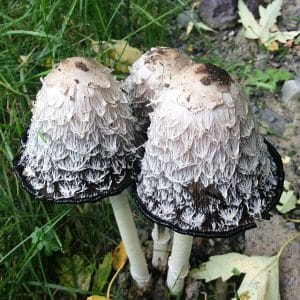
Shaggy Mane mushrooms are another easily identifiable mushroom. This mushroom is also known as the Lawyer’s Wig mushroom, which is a type of Inky Cap mushroom. This mushroom has three lookalikes, including the common Ink Cap, Snowy Ink Cap, and Wooly Ink Cap mushrooms, and is also closely related to other inky cap mushroom varieties. The Shaggy Mane mushroom commonly grows on lawns and is a primarily white mushroom that resembles the powdered, white wigs that were once commonly associated with lawyers and judges. It is important to know that when foraging these mushrooms, they dissolve into a black residue even while fresh, and will gradually dissolve more with age. The gills are known for producing an ink-like residue, hence the name Inky Cap mushroom.
Western Cauliflower Mushroom (Sparassis crispa)

Also known as the Noodle Mushroom, Cauliflower of the Woods, Silver Ear, and Snow Ear, this mushroom is an interesting-looking fungus that shares a similar appearance to cauliflower, with a twisty and curly off-white cap. While this mushroom is mostly of European origin, and somewhat uncommon, a few varieties grow in Washington. Western Cauliflower is parasitic, as it grows on dead or decaying trees. You’ll often find this variety growing in clumps between four and 10 inches wide and generally during the summer months.
Lobster Mushroom (Hypomyces lactifluorum)

The Lobster mushroom is an interesting specimen as it doesn’t grow on decaying trees or along forest floors, but rather on other species of mushrooms. This turns the outer shells of mushrooms into a bold red-orange color, similar to the shell of a lobster. Lobster mushroom often grows on members of milk cap and brittlegill mushrooms. The surface of the mushroom is hard and develops hard pimple-like bumps. This hard surface prevents the host mushroom from producing spores. The size of a Lobster mushroom depends on the host mushroom, but it often grows between six to eight inches tall.
Salt-Loving Mushroom (Agaricus bernardii)
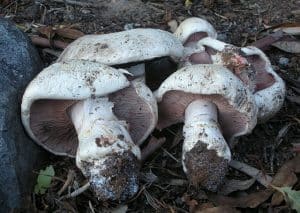
The Salt-Loving Mushroom is a short fungus that often grows in salt marshes and coastal grassland. The caps are flattened and a greyish-white color, with the gills a dull pink color in younger mushrooms. The older the mushroom, however, the darker the color of the gills will become, turning into a reddish-brown. This fungus prefers sandy soils and areas with a higher salt concentration in the soil, hence its given name.
Foraging in Southern California is easier when you have a list of a variety of mushrooms that you want to search for. Hopefully, this list will help you start your foraging journey!






